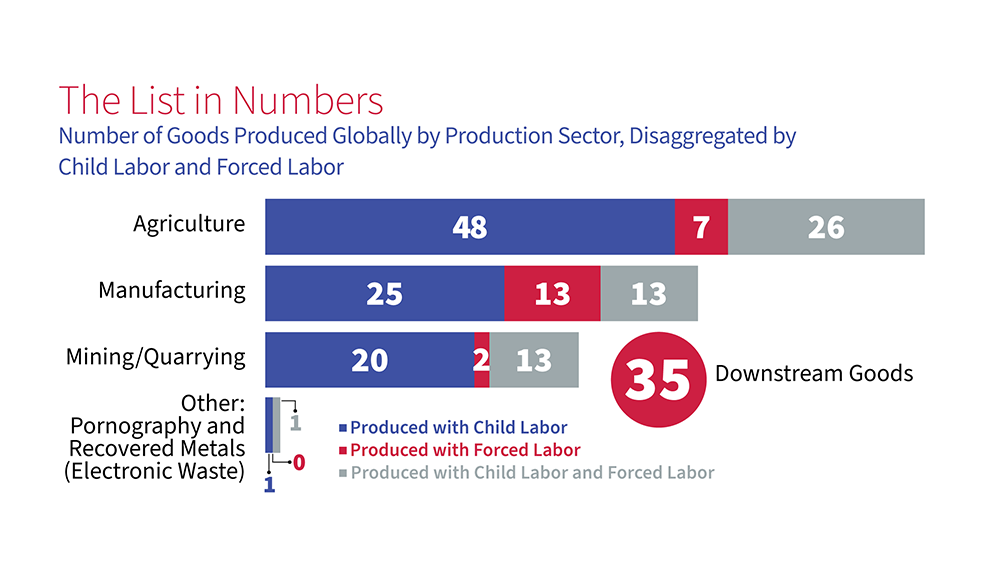List of Goods Produced by Child Labor or Forced Labor
The Bureau of International Labor Affairs (ILAB) maintains a list of goods and their source countries which it has reason to believe are produced by child labor or forced labor in violation of international standards, as required under the Trafficking Victims Protection Reauthorization Act (TVPRA) of 2005 and subsequent reauthorizations. The List of Goods Produced by Child Labor or Forced Labor comprises 204 goods from 82 countries and areas, as of September 5, 2024.
The Frederick Douglass Trafficking Victims Prevention and Protection Reauthorization Act of 2018 directs that the List include, "to the extent practicable, goods that are produced with inputs that are produced with forced labor or child labor."
ILAB maintains the List primarily to raise public awareness about forced labor and child labor around the world and to promote efforts to combat them; it is not intended to be punitive, but rather to serve as a catalyst for more strategic and focused coordination and collaboration among those working to address these problems.
Previous TVPRA List of Goods Produced by Child Labor or Forced Labor
2022
- List of Goods (Full Report) (PDF)
- List of Downstream Goods (Excel)
- List of Goods (Bibliography) (PDF)
Publication of the List has resulted in new opportunities for ILAB to engage with foreign governments to combat forced labor and child labor. It is also a valuable resource for researchers, advocacy organizations and companies wishing to carry out risk assessments and engage in due diligence on labor rights in their supply chains.
The countries on the List span every region of the world. The most common agricultural goods listed are sugarcane, cotton, coffee, tobacco, cattle, rice, and fish. In the manufacturing sector, bricks, garments, textiles, footwear, carpets, and fireworks appear most frequently. In mined or quarried goods, gold, coal and diamonds are most common.
ILAB published the initial TVPRA List in 2009 and updated it annually through 2014, following a set of procedural guidelines that were the product of an intensive public consultation process. ILAB now updates and publishes the List every other year, pursuant to changes in the law.
Procedural Guidelines
On January 25, 2024, ILAB's Office of Child Labor, Forced Labor, and Human Trafficking published Procedural Guidelines for the development and maintenance of the List of Goods from countries produced by child labor or forced labor in violation of international standards.
DOL's mission is to foster, promote, and develop the welfare of the wage earners, job seekers, and retirees of the United States. This DOL mission is carried out by a variety of sub-agencies and offices (DOL agencies) covering domestic and international policy engagements, workforce development, enforcement, statistics, and benefits. DOL has a responsibility to protect the integrity of scientific information that is produced, communicated, and used across DOL agencies to better carry out its mission. ILAB is committed to using the highest possible scientific integrity and quality standards and practices to conduct our critical work. Scientific integrity is the adherence to professional practices, ethical behavior, and the principles of honesty and objectivity when conducting, managing, using the results of, and communicating about science and scientific activities. Inclusivity, transparency, and protection from inappropriate influence are hallmarks of scientific integrity.
| Country/Area | Good | Exploitation Type |
|---|---|---|
| Dominican Republic | There are reports that adults are forced to work in the harvesting and production of sugarcane in the Dominican Republic. These adults, the majority of whom are undocumented or stateless, are predominantly of Haitian origin or descent. Reports from civil society organizations, news media, worker interviews, field research, and other sources indicate the existence of the following forced labor indicators in the sugarcane sector: withholding of wages, abusive working and living conditions, excessive overtime, isolation and restriction of movement, and deceptive recruitment practices. For some workers, a precarious legal status and lack of identity documents limit their movement and have led to isolation and fears of reprisal, denouncement to authorities, loss of company-provided housing and deportation for complaining about unlawful labor conditions. In addition, illiteracy, low levels of education, and language barriers can impede their understanding and exercising of labor rights, thus increasing their vulnerability to labor exploitation. |
Child Labor, Forced Labor |
| El Salvador | Child Labor | |
| Guatemala | Child Labor | |
| India | Research found that sugarcane in India, especially sugarcane harvested in Maharashtra, is harvested using forced labor of adults. Workers in the sugarcane fields face excessive and involuntary overtime, severe and unexplained wage deductions, and degrading living conditions. They are commonly recruited against a debt, often resulting often in debt bondage. Women are frequently pressured into receiving unnecessary hysterectomies to avoid taking leave and missing harvesting quotas. |
Child Labor, Forced Labor |
| Kenya | Child Labor | |
| Mexico | Child Labor | |
| Pakistan | Forced Labor | |
| Paraguay | Child Labor | |
| Philippines | Child Labor | |
| Thailand | Child Labor |
your hand? Download ILAB's Sweat & Toil App today!
Are you a company looking to fight child labor and forced labor in supply
chains?


